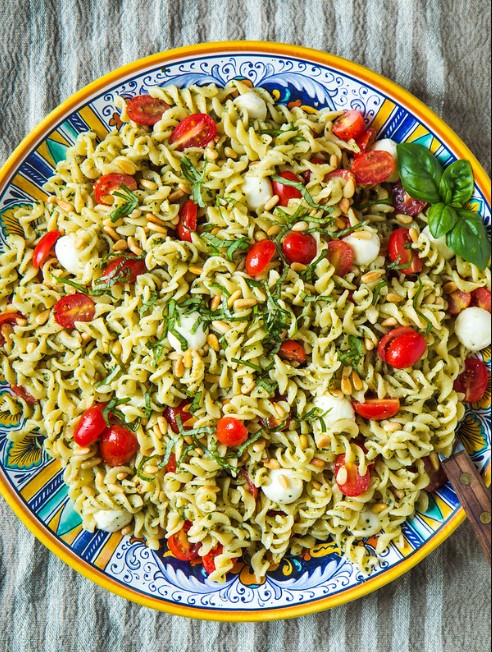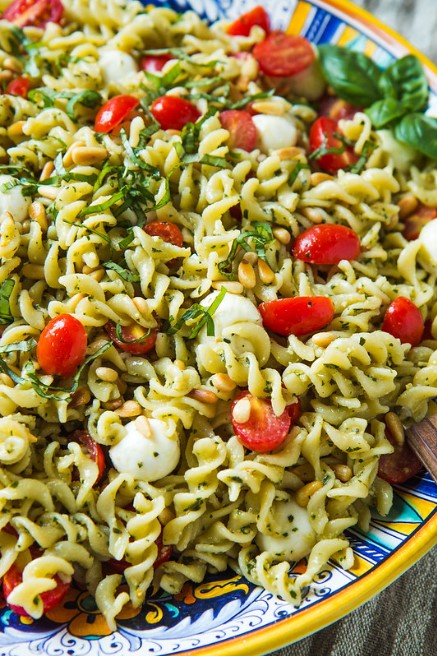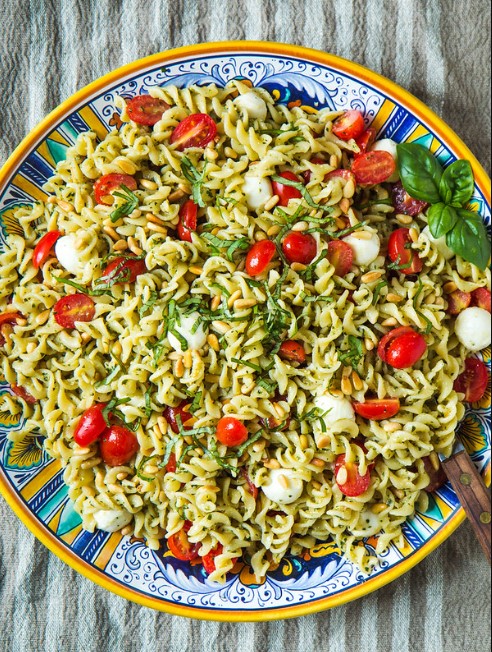
I’m not a big fan of most pasta salads, but there is one major exception to that rule: pesto pasta salads. I don’t know what it is about pesto that makes serving cold pasta acceptable to me, but whatever it is, I won’t argue with it. I just love it.
Making a pasta salad like this is really very simple, which is why it’s my go-to for potlucks and the like (I snapped the photo above right before rushing off to a fourth of July celebration, in fact), but as I was making it this time, I realized there are a lot of little things that go into making it as good as it can possibly be, and I thought I would share what I know with you.
These tips might seem insignificant, but when used in unison, they can make a good pasta salad great.

- Use fresh pesto. Making your own pesto is an extra step that is well worth the (minimal) effort it entails. Basil is at its best this time of year, and simply can’t be beat, especially if you can pick it straight from your own back yard. If you can’t, buying fresh basil can get kind of pricey… but instead of opting for a jar of pre-made stuff, try using arugula or spinach in place of some of the basil to bulk up your pesto. (Bonus tip: fresh parmesan makes a huge difference, too, but the good stuff can be expensive. Sub some good quality pecorino for the parm, and you’ll save big time!) You can find my basic recipe for pesto, along with lots of ideas for variation, here.
- Roast your garlic. I love lots of garlic in my pesto, but I don’t love the harsh bite it can have when it’s raw. Roasting makes it sweet and fragrant, and eliminates any sharp pungency. You can see my tutorial on how to roast garlic, here. (Bonus tip: if you’re like me and don’t want to run the oven in the middle of summer, simply wrap your garlic in a pouch of foil, along with a drizzle of olive oil, and throw it on the grill over low, indirect heat. Close the lid and keep an eye on it for 20-30 minutes for individual cloves, or 30-40 minutes for a whole head, or until the garlic is soft and golden. While you’ve got the grill going, go ahead and slice a lemon in half and throw it on for a minute or two, then squeeze the juice into your pesto, too!)
- Toast your nuts. Toasted pine nuts are world’s tastier than raw, and they are beyond easy to make. Just add your nuts to a dry pan over medium – medium-low heat. Keep on eye on them and stir or shake the pan frequently to keep them from burning. Once the nuts turn golden brown, you’re good to go. (Don’t want to spend the big bucks for pine nuts? Swap them out for other nuts, or sunflower seeds. Just be sure to toast them first!)
- Save your pasta water. Once your pesto is made, add a few TBSP of the pasta cooking liquid to thin it to a more sauce-like consistency. The starchy water will not only thin the pesto, but help it cling to the pasta instead of sliding off.
- Choose noodles that can hold on to the sauce. Okay, this might sound fussy, but using a noodle that has a lot of surface area means more pesto in every bite — and that’s a good thing. I like fusilli or gobetti, but any spiral-y shaped pasta will do.
- Cook the noodles properly, according to the temperature you plan to serve them at. If you plan on serving your pasta cold or at room temperature, cook the noodles just beyond al-dente, since the pasta will firm up slightly once cooled.
- As a general rule of thumb, you’ll need at least one cup of pesto per pound of pasta. If you’re making the dish in advance, be sure to use more pesto than you think you’ll need, as the pasta will absorb a lot of the sauce as it cools, and can become dry. If it does get dryer than you’d like, simply stir in a little more pesto, or a drizzle of olive oil, to moisten it.
- My favorite pesto pasta salad consists of small balls or torn chunks of fresh mozzarella, halved cherry or grape tomatoes, toasted pine nuts, and lots of fresh basil for garnish (but of course, you’re welcome to change up these add-ins however you’d like). If you’re planning to refrigerate your salad before serving, leave the cherry tomatoes out until you’re ready to serve — they taste best at room temperature. Pasta salad can be stored in the fridge for up to a day in advance, but is best removed from the fridge an hour before serving to take the chill off.

And now, without further ado… the recipe!
What’s your favorite kind of pasta salad? Do you have a go-to recipe? I’d love to know (and if you have any tips or tricks of your own, feel free to share them in the comments below!).
CAPRESE PASTA SALAD
Serves: 6-8 servings
INGREDIENTS
- 1 lb. fusilli or other spiral-shaped pasta
- 1 pint cherry tomatoes, halved
- 8 oz. fresh mozzarella, either small balls or torn chunks
- ½ cup pine nuts, toasted
- 3-4 TBSP chiffonade of fresh basil, for garnish
- For the pesto:
- 1½ cups fresh basil, lightly packed
- ½ cup pine nuts, toasted (can sub walnuts or sunflower seeds)
- ½ cup freshly grated parmesan cheese (can sub pecorino)
- 5-6 cloves garlic, roasted (or 2-3 cloves raw)
- 2-3 TBSP fresh lemon juice, to taste
- ½-3/4 cup good quality olive oil
- big pinch of salt, to taste
INSTRUCTIONS
- In a blender, combine all the pesto ingredients except the olive oil. While blending, drizzle in the olive oil until the pesto has reached desired consistency. Taste, and add more salt or lemon juice as needed. Set aside.
- Cook pasta until al-dente, if serving the salad warm, or just past al-dente, if you plan to serve it cold or at room temperature. Reserve ¼-1/2 cup pasta water before draining.
- Thin the pesto with 2-3 TBSP pasta water to create a more sauce like consistency, then pour the pesto over the pasta while it is still warm. Toss to combine, adding more pasta water as needed until the pasta is coated evenly.
- If serving immediately, add the cherry tomatoes, mozzarella, and toasted pine nuts, and garnish with a chiffonade of fresh basil. If making in advance, cover and store in the fridge, then mix in the tomatoes, mozzarella, and pine nuts just before serving. If the pasta becomes too dry, add a little more pesto, or a drizzle of olive oil, as needed. Can be made up to a day in advance.
